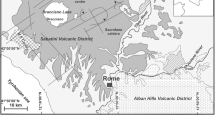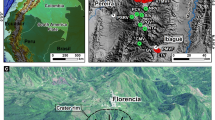Abstract
Carbonatite lavas and pyroclastic rocks are exposed in the volcanic graben of Catanda and represent the only known example of extrusive carbonatites in Angola. A new detailed geological map of the area is presented in this study as well as six different stratigraphic sections. Pyroclastic rocks, apparently unwelded, are dominant in the area and represented in all the stratigraphic columns. They form shallowly to moderately inclined layers, mostly devoid of internal structures, that range in thickness from several centimetres to metres. They are dominantly lapilli tuffs and minor tuffs occasionally comprising pelletal lapilli. Based on their different features and field relationships, at least five different pyroclastic lithofacies have been distinguished in the area. Carbonatitic lavas outcrop in the external parts of the Catanda graben, forming coherent layers interbedded with pyroclastic rocks. Calcite is the most common mineral in the lavas, but other accessory minerals such as fluorapatite, titaniferous magnetite, phlogopite, pyrochlore, baddeleyite, monticellite, perovskite, cuspidine and periclase have also been identified. At least four different types of lavas have been distinguished based on their mineral associations and textural features. This study reveals an overall abundance of pyroclastic material in comparison to lava flows in the Catanda area, suggesting that eruptive processes were dominated by explosive activity similar to what has been described in other carbonatite and kimberlite localities. The Catanda carbonatitic volcanism was associated with monogenetic volcanic edifices with tuff ring or maar morphologies, and at least seven possible eruptive centres have been identified in the area.










Similar content being viewed by others
Notes
Pelletal lapilli are defined as spherical to elliptical lapilli commonly with a crystal fragment or a lithic clast in the centre, mantled by fine-grained micro-phenocrystal material that sometimes defines smooth concentric layers (Mitchell 1997).
References
Alberti A, Castorina F, Censi P, Comin-Chiaramoni P, Gomes CB (1999) Geochemical characteristics of Cretaceous carbonatites from Angola. J Afr Earth Sci 29:735–759
Bailey DK (1993) Carbonate magmas. J Geol Soc Lond 150:637–651
Barker DS, Nixon PH (1989) High-calcium, low-alkali carbonatite volcanism at Fort Portal, Uganda. Contrib Mineral Petrol 103:166–177
Bell K (1989) Carbonatites: genesis and evolution. Unwin Hyman Ltd, London, p 618
Brown RJ, Buse B, Sparks RSJ, Field M (2008) On the welding of pyroclasts from very low-viscosity magmas: examples from kimberlite volcanoes. J Geol 116:354–374
Dawson JB (1993) A supposed sövite from Oldoinyo Lengai, Tanzania: result of extreme alteration of alkali carbonatite lava. Mineral Mag 57:93–101
Dawson JB, Pinkerton H, Norton GE, Pyle DM, Browning P, Jackson D, Fallick AE (1995) Petrology and geochemistry of Oldoinyo Lengai lavas extruded in November 1988: magma source, ascent and crystallization. In: Bell K, Keller J (eds) Carbonatite volcanism. Oldoinyo Lengai and the petrogenesis of natrocarbonatite IAVCEI Proceedings in Volcanology 4 pp 47-69
De Boorder H (1982) Deep-reaching fracture zones in the crystalline basement surrounding the West Congo System and their control of mineralization in Angola and Gabon. Geoexploration 20:259–273
Deans T, Roberts B (1984) Carbonatite tuffs and lava clasts of the Tinderet foothills, western Kenya: a study of calcified natrocarbonatites. J Geol Soc Lond 141:563–580
Eby GN, Lloyd FE, Woolley AR (2009) Geochemistry and petrogenesis of the Fort Portal, Uganda, extrusive carbonatite. Lithos 113:785–800
Eley R, Grütter H, Louw A, Tunguno C, Twidale J (2008) Exploration geology of the Luxinga kimberlite cluster (Angola) with evidence supporting the presence of kimberlite lava. Extended Abstr. No. 9IKC-A-00166, 9th International Kimberlite Conference, Frankfurt
Gernon TM, Brown RJ, Tait MA, Hincks TK (2012) The origin of pelletal lapilli in explosive kimberlites eruptions. Nature Communications 3: article 832
Gomes CSF (1971) Ocorrência de cromita no carbonatito vulcânico da Catanda (Angola). Boletim dos Servicos de Geologia e Minas de Angola 20:55–59
Haggerty SE, Raber E, Naeser CW (1983) Fission track dating of kimberlitic zircons. Earth Planet Sci Lett 63:41–50
Hay RL (1978) Melilite-carbonatite tuffs in the Laetoli beds of Tanzania. Contrib Mineral Petrol 67:357–367
Hay RL (1983) Natrocarbonatite tephra of Kerimasi volcano, Tanzania. Geology 11:599–602
Hayward CL, Jones AP (1991) Cathodoluminescence petrography of middle proterozoic extrusive carbonatite from Qasiarsuk, South Greenland. Mineral Mag 55:591–603
Issa Filho A, Dos Santos ABRMD, Riffel BF, Lapido-Loureiro FEV, McReath I (1991) Aspects of the geology, petrology and chemistry of some Angolan carbonatites. J Geochem Explor 40:205–226
Jelsma H, Krishnan U, Perrit S, Preston R, Winter F, Lemotlo L, v/d Linde G, Armstrong R, Phillips D, Joy S, Costa J, Facatino M, Posser A, Kumar M, Wallace C, Chinn I, Henning A (2012) Kimberlites from Central Angola: a case study of exploration findings. 10th International Kimberlite Conference, Bangalore, Extended Abstr. No. 10IKC-42: 1-5
Keller J (1981) Carbonatitic volcanism in the Kaiserstuhl alkaline complex: evidence for highly fluid carbonatitic melts at the Earth’s surface. J Volcanol Geotherm Res 9:423–431
Keller J (1989) Extrusive carbonatites and their significance. In: Bell K (ed) Carbonatites: genesis and evolution. Unwin Hyman, London, pp 70–88
Keller J, Zaitsev AN (2006) Calciocarbonatite dikes at Oldoinyo Lengai, Tanzania: the fate of natrocarbonatite. Can Mineral 44:857–876
Lapido-Loureiro FE (1968) Sub-volcanic carbonatite structures of Angola. Int Geol Congr (Prague), 23rd session, pp 147-161
Lapido-Loureiro FE (1973) Carbonatitos de Angola. Memórias e Trabalhos do Instituto de Investigação Científica de Angola 11:1–242
Lloyd EF, Stoppa F (2003) Pelletal lapilli in diatremes—some inspiration from the old masters. Geolines 15:65–71
Mariano AN, Roeder PL (1983) Kerimasi: a neglected carbonatite volcano. J Geol 91:449–455
Melgarejo JC, Costanzo A, Bambi ACJM, Gonçalves AO, Neto AB (2012) Subsolidus processes as a key factor on the distribution of Nb species in plutonic carbonatites: the Tchivira case, Angola. Lithos 152:187–201
Mitchell RH (1997) Kimberlites, organgeites, lamproites melilitites and minettes: a petrographic atlas. Almaz Press, Thunder Bay, Canada
Nixon PH, Hornung G (1973) The carbonatite lavas and tuffs near Fort Portal, Western Uganda. Overseas Geology and Mineral Resources, Institute of Geological Sciences, London 41: 168–179
Peres AM, Gomes CF (1969) Baddeleite da Catanda, Angola. Boletim dos Serviços de Geologia e Minas de Angola 18:27–34
Peres AM, Gomes CF, Cardoso-Simões MV (1968) As variedades semi-preciosas de olivina da Catanda-Angola. Boletim dos Serviços de Geologia e Minas de Angola 18:5–15
Peterson TD (1990) Petrology of natrocarbonatite. Contrib Mineral Petrol 105:143–155
Riley TR, Bailey DK, Lloyd FE (1996) Extrusive carbonatite from the Quaternary Rockeskyll Complex, West Eifel, Germany. Can Mineral 34:389–401
Robles-Cruz SE, Escayola M, Jackson S, Galí S, Pervov V, Watangua M, Gonçalves A, Melgarejo JC (2012) U-Pb SHRIMP geochronology of zircon from the Catoca kimberlite, Angola: implications for diamond exploration. Chem Geol 310–311:137–147
Silva MVS, Pereira E (1973) Estrutura Vulcânico-Carbonatitica da Catanda (Angola). Boletim dos Serviços de Geologia e Minas de Angola 24:5–14
Stoppa F (1996) The San Venanzo maar and tuff ring, Umbria, Italy: eruptive behaviour of a carbonate-melilitite volcano. Bull Volcanol 57:563–577
Stoppa F, Lavecchia G (1992) Late-Pleistocene ultra-alkaline magmatic activity in the Umbria-Latium region (Italy): an overview. J Volcanol Geotherm Res 52:277–293
Stoppa F, Lupini L (1993) Mineralogy and petrology of the Polino monticellite calciocarbonatite (Central Italy). Mineral Petrol 49:213–231
Stoppa F, Principe C (1998) Eruption styles and petrology of a new carbonatitic suite from the Mt. Vulture (Southern Italy): the Monticchio Lakes Formation. J Volcanol Geotherm Res 80:137–153
Stoppa F, Schiazza M (2013) An overview of monogenetic carbonatitic magmatism from Uganda, Italy, China and Spain: volcanologic and geochemical features. J S Am Earth Sci 41:140–159
Sykes L (1978) Intraplate seismicity, reactivation of pre-existing zones of weakness, alkaline magmatism, and other tectonism postdating continental fragmentation. Rev Geophys 16:621–688
Torró L, Villanova C, Castillo M, Campeny M, Gonçalves AO, Melgarejo JC (2012) Niobium and rare earth minerals from the Virulundo carbonatite, Namibe, Angola. Mineral Mag 76:393–409
Von Knorring O, Du Bois CGB (1961) Carbonatitic lava from Fort Portal area in western Uganda. Nature 192:1064–1065
White JDL, Houghton BF (2006) Primary volcaniclastic rocks. Geology 34:677–680
White JDL, Ross P-S (2011) Maar-diatreme volcanoes: a review. J Volcanol Geotherm Res 201:1–29
Woolley AR (2001) Alkaline rocks and carbonatites of the world. Part 3: Africa, Geological Society of London, London
Woolley AR, Church AA (2005) Extrusive carbonatites: as brief review. Lithos 85:1–14
Zaitsev AN (2010) Nyerereite from calcite carbonatite at the Kerimasi Volcano, Northern Tanzania. Geol Ore Depos 52:630–640
Zaitsev AN, Keller J (2006) Mineralogical and chemical transformation of Oldoinyo Lengai natrocarbonatites, Tanzania. Lithos 91:191–207
Zaitsev AN, Wenzel T, Venneman T, Markl G (2013) Tinderet volcano, Kenya: an altered natrocarbonatite locality? Mineral Mag 77(3):213–226
Zimanowski B, Büttner R, Lorenz V, Häfele H-G (1997) Fragmentation of basaltic melt in the course of explosive volcanism. J Geophys Res 102:803–814
Acknowledgments
This research has been supported by project CGL2009-13758 of the Spanish Government and projects SGR-589 and SGR-444 of the Generalitat de Catalunya. Fieldwork in Catanda was also supported by the Hugh E. McKinstry fund, granted by the Society of Economic Geologists. Logistical assistance in the field was provided by the Departamento de Geologia da Universidade Agostinho Neto from Luanda, Angola. We acknowledge the collaboration and the hospitality of Felipe Correia and José Fortuna from Catanda village. We thank F. Stoppa, an anonymous reviewer and associate editor P.-S. Ross for their constructive comments.
Author information
Authors and Affiliations
Corresponding author
Additional information
Editorial responsibility: P-S Ross
Rights and permissions
About this article
Cite this article
Campeny, M., Mangas, J., Melgarejo, J.C. et al. The Catanda extrusive carbonatites (Kwanza Sul, Angola): an example of explosive carbonatitic volcanism. Bull Volcanol 76, 818 (2014). https://doi.org/10.1007/s00445-014-0818-6
Received:
Accepted:
Published:
DOI: https://doi.org/10.1007/s00445-014-0818-6




